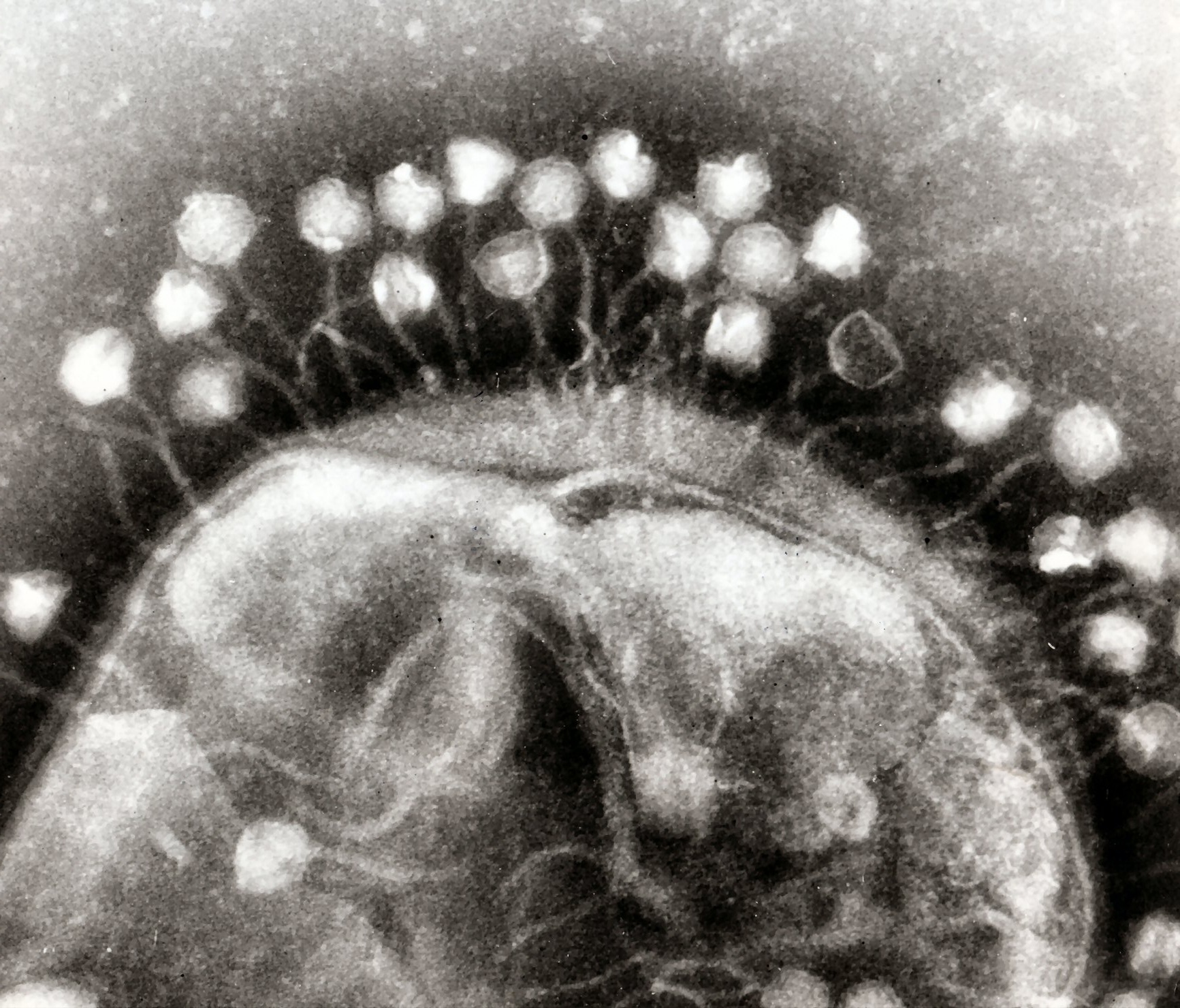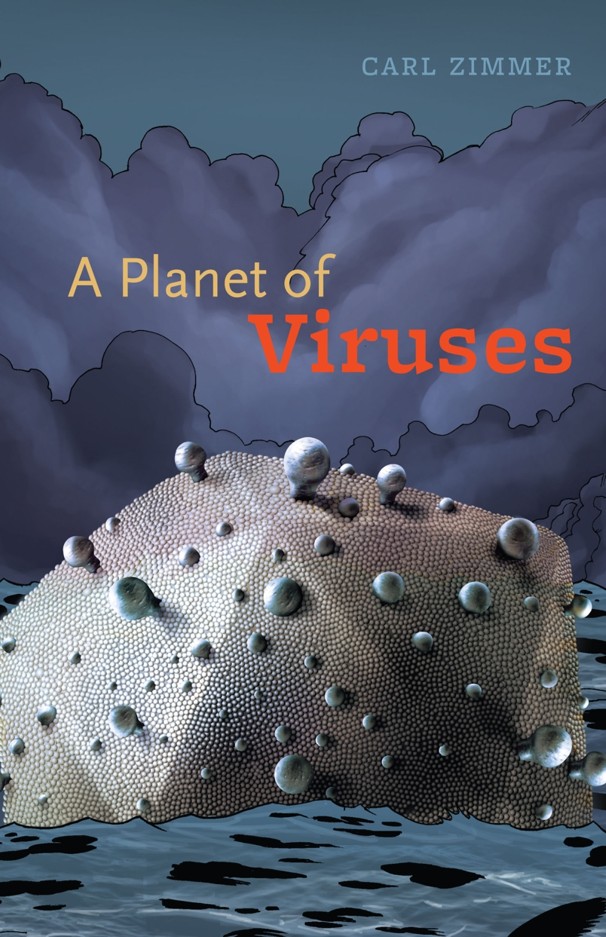Review: A Planet of Viruses

“[Viruses are] biology’s living matrix.”
We share little in common with our forebears’ understanding of the universe. In ancient times the earth was ensconced by a dome or firmament which held back rain and other effusions from above. Drought and wetness were tangible indicators of the pantheon’s impression of earthly behavior, with a blue sky betokening the rain that lay just beyond the earth’s protective shell. For many of our ancestors, the stars influenced the health of those on earth; for others, calamity and human hardship could be ascribed to nothing more than the shifting dispositions of the local deities. Maladies of the skin and throat and other physiological dysfunction were regarded as plagues, or instances of pestilential terror cast down as punishment. It was not until our discovery of the virus that these superordinary affiliations were shorn in favor of the vanishingly tiny world thriving right under our noses.
Viruses have been invading other life forms for billions of years with nary an invitation, yet our knowledge of this relatively young science is still fairly limited. Helming this microcosmic thrill ride in A Planet of Viruses is Carl Zimmer, first-place recipient of the 2012 AAAS Kavli Science Journalism competition and one of the most illustrious science reporters of our time. Author of Microcosm and Parasite Rex, pathogen science has long been his forte. In his latest and most abbreviated work, Zimmer marshals his treasure of insights and provides us a sweeping introduction to this fascinating, if ineluctably unnerving world.
The book is organized as a compilation of well-connected short essays, a format that suits the material well. Each of the chapters spotlights a specific strain or type of virus which has wreaked considerable chaos on human welfare–from rhinovirus, smallpox, and influenza to HIV and West Nile–and Zimmer’s characteristic story-centric style makes each vignette as rousing as the last. As you progress, Zimmer slowly raises the curtain on virus ingenuity, weaving accessible tales and the latest research and statistics throughout.
The Infiltrator
Since viruses first breached the scientific periphery in the 19th century, over 5,000 separate strains have been identified, with possibly tens of thousands more harboring in the oceans and lining the guts of every species on earth. While they can vary broadly in physical size, shape, number of genes, and mobility within and between hosts, they all borrow from the same playbook. At the first, a virus requires a host to survive, unlike bacteria, so its blinkered priority is to gain access to the cellular machinery of other life forms. Whether it’s animals and plants or bacteria and archaea, a virus does not discriminate.
I like to think of them as the world’s smallest stealth agent, as resourceful as they are deadly. In what makes Ethan Hunt look like an amateur, a virus has the ability to infiltrate a host’s cells in a variety of ways, a skill which amplifies as evolution takes its course. Once the virus descends upon the host’s genetic structure, it can really begin its work. With full access to the genetic database the virus begins installing its own DNA onto the cells of its host, overriding the host’s DNA. At this point, the virus is replicated by the host’s hijacked DNA at a prodigious rate until many thousands of identical copies line the inside of the host’s cells. Depending on the genetic mixture, this assimilation can disrupt a host gene’s ability to make proteins, unleashing havoc on the unwitting custodian, or the virus presence can trigger the release of antibodies which scramble to shut down the intruders, subjecting the host to nasty symptoms in the process.
There is ongoing debate over whether viruses qualify as a form of life. They cannot survive outside of a host cell and are absent any kind of cellular architecture, rendering them little more than small, self-assembling clusters of nucleic acids. Even so, Zimmer is quick to point out their indispensable role in shaping and sustaining life over the aeons. “We humans are an inextricable blend of mammal and virus. Remove our virus-derived genes, and we would be unable to reproduce.” (p. 93)
Viruses have also been implicated in the origin of life, as their capacity for self-replication may hold the keys to how precellular material jumpstarted the chain of life on earth.1 The uninvited stowaways have been shuffling genes among different host species ever since, comprising as much as 8% of the human genome.2 Thus not only have viruses been a tremendous force in the evolution of life on this planet, they are essential to our survival.
Zimmer also discloses plainly just how near are viruses and other infectious agents. Each of our trillions of cells can contain hundreds of viruses and bacteria.3 Human papillomavirus (HPV), most known for inflicting cervical cancer and killing over 270,000 women every year, is actually quite common and can be found nestled in your skin cells.4 We constantly shed our outermost layer of skin after cell death, depositing the virus-laden DNA all around us. That means that right now you likely have more than a few HPV viruses on the desk and laptop in front of you. Not the cheeriest thought perhaps, but you will find solace in the fact that the majority of HPV strains are benign and pose no immediate risk.
Cat, Meet Mouse
It is true that the lion’s share of known viruses introduce no changes to infected cells or simply lie dormant within our DNA. But it is also true that pathogens evolve more quickly than any known form of life. For this reason microbe trajectories always lie one step ahead of us and are difficult, if not impossible, to predict. Zimmer relates this chilling reality by describing why scientists are urging against the over-use of antibiotics. Not only do antibacterials have a null effect on viruses, they upset the delicate ecosystem inside our bodies and ‘incentivize’ bacteria to evolve countermeasures, potentially resulting in more noxious versions of both benign and harmful strains.
In response to this dilemma, many medical biologists now have their eyes on an alternative approach to fighting bacteria: phage therapy, an area in which precious little research has been conducted. Somewhat confusingly, a bacteriophage is a virus used to combat resilient bacteria. Essentially, pitting pathogen against pathogen. Zimmer tells of a lab-engineered phage (pictured below) developed by a team from Boston University and MIT that can wipe out 99.997% of E. coli strains. More impressively, “scientists at the Eliava Institute have developed a dressing for wounds that is impregnated with half a dozen different phages, capable of killing the six most common kinds of bacteria that infect skin wounds.” (p. 38) Among many microbiologists, this approach to resistant bacteria is a heavily favored alternative to antibiotics. But until a wider body of research is explored, such precision warfare is confined to the lab.
Exit: Stage Left
By all accounts, the most uplifting installment is that of smallpox, which Zimmer recounts in a coda entitled “The Long Goodbye.” When this dark scourge first started replicating inside of human hosts remains an open question. Telltale signs can be seen in the 3,000 year old mummified corpse of Pharaoh Ramses V, while other scientists date its emergence as early as 10,000 BC. Based on extant medical records and fatality rates, it’s been estimated that smallpox caused 400,000 European deaths each year during the 18th century and another 300-500 million deaths in the 20th century alone, bringing down three empires in the process. Its final death toll across human history and its legacy in shaping civilization may never be fully realized, but it met a worthy competitor in one Edward Jenner.
Among the venerated elite in science history, Jenner used cowpox, a member of the same viral family as smallpox, to inoculate potential smallpox victims. It worked, and while Jenner did not discover the antigenic properties activated by vaccination, it was his “trial by fire” testing and scrupulous documentation of his findings that led to its widespread adoption against smallpox. In 1979, the World Health Organization declared smallpox an eradicated disease. The unflinching bravura of those who risked their lives in the global eradication effort functions as a testament to human possibility. WHO’s vaccination campaigns, which achieved success largely by isolating the infected from the non-infected and administering vaccines to quarantined communities, is perhaps the greatest success story in all of medicine and lends hope for the outcome of future travails.
Closing Thoughts
Thanks to one of the finest science communicators today, the remaining essays assembled in A Planet of Viruses are every bit as informative and accessible. As stepladder to the scientific community, Zimmer has a knack for engaging readers of all stripes, from the layperson to the armchair scientist to anyone who simply likes reading good stories. His way is precise, not overly simplified, choosing just the right level of linguistic precision to divulge this teeming underworld to his readers. While certainly not as detailed as some of his earlier expositions, this brilliant anthology serves as a perfect preamble to the bustling field of microlife. Clocking in at just under 100 pages, I highly recommend you target this one for your next free weekend, preferably before, and not after, having eaten.
Note: This review is mirrored over at Goodreads and at Amazon.
Feature image credit: rost9 — 3D illustration pathogenic viruses causing infection in host organism.
- “Virus self-assembly within host cells has implications for the study of the origin of life, as it lends further credence to the hypothesis that life could have started as self-assembling organic molecules.” (Koonin et al 2006)
[↩]
- “To put that figure in perspective, consider that the 20,000 protein-coding genes in the human genome make up only 1.2 percent of our DNA”. (p. 52) Zimmer offers that our identity is tied up more in ancient virus than in anything we can call “us”.
[↩]
- Viruses are the most abundant form of microorganism on the planet. There are an estimated 10^31 viruses (read: not distinct strains or species) currently flourishing within the cells of unwitting hosts. Written out, that number looks like:
10,000,000,000,000,000,000,000,000,000,000
Parenthetically, there are also 10^30 bacteria on earth, so naturally they’re the most abundant hosts for viruses. It could in fact be said that biology is 99% micro.
[↩]
- Cervical cancer is the third leading cause of death in women, just behind breast cancer and lung cancer.
[↩]




Comments